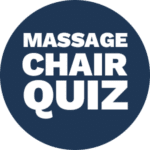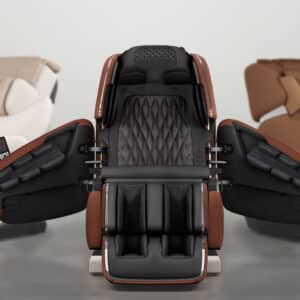

What is a Massage Chair L-Track, S-Track?
Share this article:
The market for personal massage equipment is growing exponentially. If you’re just dipping your toe into the world of massage chairs for the first time, you’re sure to be amazed. Who knew there could be so many different factors to consider when selecting the best chair for you?
Types of tracks, rollers, 2D, 3D, and 4D massage chairs—which one will deliver the results you’re looking for? The number of features available can be both exciting and, frankly, a little overwhelming.
That’s why we wrote this article. It’s a handy guide with information on some of the most important core functionality. Confused about L-track vs. S-track? We’ve got you covered.
Massage Chair Basics
When looking to purchase a massage chair—especially for the first time—you’ll encounter many new terms. To help you communicate effectively with sales reps and others in the industry, we’ve provided definitions for some of the most important words and phrases in the massage chair vocabulary.
You shouldn’t make up your mind about features until you try them, of course. Only then will you know if you want an L-track massage chair or an S-track massage chair. But having a basic idea of what the terms mean will be helpful in your research.
Rollers and Massage Mechanisms
Before you can understand the importance of the massage track, you need to understand what rollers and massage mechanisms are. Rollers are the parts of the massage chair that make contact with your body, standing in for the fingers and palms of a human massage therapist. They are attached to the massage mechanism (sometimes shortened to “mech”), which is responsible for moving the rollers to perform actions like kneading and tapping, as well as controlling the area covered by the rollers and their depth. The massage mechanism, in turn, moves along a track (see below) inside the back of the chair. There can also be rollers in the footrests, legrests, and armrests of a massage chair to provide massage for those areas of the body.
Tracks
Tracks are the paths massage mechanisms take up-and- down the chair back and into the seat, in some cases. They mainly affect the “reach” of a massage. Chairs typically have an L-track or an S-track as described below, though some chairs have a hybrid track, also explained below.
L-Track vs. S-Track
So what is an S-track, what is an L-track, and what do they change about the massage?
An S-track starts at the neck and ends at the lower back, and frequently includes curvature to match the shape of the spine—hence the “S.” An L-track, on the other hand, starts at the neck and curves under the buttocks to end in the seat of the chair, which gives it an “L” shape. Some L-tracks feature curves to match the contour of the back (sometimes called SL-tracks), and some do not.
You might be thinking, “An L-track covers more of my body, so it must be better.” This is not necessarily true. Each track type has pros and cons.
S-track chairs recline where the chair back meets the seat, which allows it to place you in the lie-flat position and perform a better full-body stretch. However, S-track chairs typically cannot massage the glutes as well as L-track chairs, and they cannot reach the zero gravity position (read more below).
L-track chairs, conversely, typically are able to massage the glutes and place you in the zero gravity position. They cannot, however, achieve the lie flat position, which limits the extent of the full-body stretch they can provide.
Hybrid Tracks, J-Tracks, and Flex Tracks
Hybrid tracks, Flex-tracks, or J-tracks (or in the case of OHCO chairs, MaxTrack™) provide the best of both worlds. They can achieve both lie-flat and zero gravity position, with all their associated benefits, including an excellent full-body stretch. And they can effectively extend the massage range to reach the glutes.
Does this mean that a chair with a J-track is inherently better than a chair with an S-track or L-track? No. Track type is just one feature, albeit an important one. What is most critical is how well a chair addresses your particular needs, which could have more to do with the massage mechanism and choreography, heat and air cell coverage, or any other number of factors.
Zero Gravity
Zero gravity refers to a massage chair that can recline in a specific and special way. When you’re in this “weightless” position, your weight is distributed evenly, and your spine is relieved of body weight. The legs-above-heart position of zero gravity chairs reduces the strain on your heart, allowing it to pump energizing oxygen through the body more efficiently. It also provides relief to tired, sore muscles, as well as reducing the effects of high blood pressure, atherosclerosis, diabetes, varicose veins, and edema.
As your body experiences this relief, you can rest, relax, and truly heal. It’s a sensation you won’t experience sitting in a typical recliner, lying in bed, or anywhere else.
A massage chair doesn’t have to offer a zero gravity position to be effective, but you only have to experience zero gravity once to know that it’s extremely comfortable and a feature that might factor into your purchase decision.
Inversion
This is another form of reclining, but the chair doesn’t make you feel weightless. Rather, it “inverts” your body’s normal position, putting your feet slightly higher than your head.
What’s the benefit of inversion? People with spinal issues can experience relief through decompression of the spine. The inverted position can also increase blood flow, creating a soothing effect throughout the body.
2D, 3D, and 4D Massage Chairs
A chair’s categorization as 2D, 3D, or 4D determines its intensity and movement capabilities. In a chair with 2D (two-dimensional) functionality, the rollers move in just two directions: up and down and side to side. Or, to be more descriptive, the rollers function on the X and Y axes.
These chairs almost exclusively have an S-track. When it was first developed, 2D capability was revolutionary. However, technology has moved forward considerably since then. Today, most people prefer the greater movement and finesse of 3D and 4D chairs.
The rollers in a 3D massage chair move up and down and side to side, but they also move in and out. In other words, their movement covers the X, Y, and Z axes. The in and out movements enable the chair to more closely match the movements of a massage therapist’s hands. As a result, it can mimic many massage styles with impressive accuracy.
The latest in massage chair technology is 4D. However, that name can be a bit of a misnomer. And for those who understand geometry, it can leave you wondering where that fourth axis is! 4D refers to greater speed control that leads to an enhanced massage. Massage therapists vary the speed of their body work as they identify trouble spots. They slow down or pause and address tighter areas to ensure the tension gets released. If you’re looking for massages that are nearly indistinguishable from those provided by a skilled massage therapist, 4D is for you.
L-Track vs. S-Track? Zero Gravity? 3D or 4D? Which Massage Chair is Right For You?
Picking the right chair involves a few steps. The first is talking with one of our Furniture For Life Comfort Consultants. They’re experts in massage chair features and functions. But perhaps more importantly, they’re experts in the needs of massage chair users.
Maybe you’re a competitive athlete who needs a chair that promotes recovery and healing after intense workouts. Perhaps your focus is more on relaxing after busy, stressful workdays. Finding the perfect pairing of person and product doesn’t start with the chair—it starts with you.
Having learned about your wants and needs, the Comfort Consultant can advise you on which massage chairs from our curated collection of the world’s best seem to be good candidates. But, of course, the only way to know whether a chair checks all your boxes and hits all your stress points is to try it. We strongly encourage customers to experience several massage chairs, experimenting with all the settings of each.
In that process, you might find that a 4D L-track massage chair is great, but a 3D L-track massage chair will work just fine. Or maybe your glutes are never a problem, and an S-track chair reaches every area you’re concerned about. Zero gravity? Maybe it’s essential to you, or maybe you’re not likely to use that position.
The bottom line is that you should take your time and be confident with your purchase. The massage chairs we offer are built to last, so yours will be a prized possession for many years to come!











